

AGENDA
Ordinary meeting of the
Planning and Regulatory Committee
Thursday 4 April 2019
Commencing at 1.00p.m.
Council Chamber
Civic House
110 Trafalgar Street, Nelson
Pat Dougherty
Chief
Executive
Membership: Councillor Brian McGurk (Presiding Co-Chairperson),
Her Worship the Mayor Rachel Reese (Co-Chairperson), Councillors Luke Acland,
Ian Barker, Bill Dahlberg, Kate Fulton, Stuart Walker and Ms Glenice Paine
Quorum: 4
Nelson
City Council Disclaimer
Please
note that the contents of these Council and Committee Agendas have yet to be
considered by Council and officer recommendations may be altered or changed by
the Council in the process of making the formal Council decision.
Guidelines for councillors
attending the meeting, who are not members of the Committee, as set out in
Standing Order 12.1:
·
All councillors, whether or not they are members of the
Committee, may attend Committee meetings
·
At the discretion of the Chair, councillors who are not Committee
members may speak, or ask questions about a matter.
·
Only Committee members may vote on any matter before the
Committee
It is good practice for both Committee members and
non-Committee members to declare any interests in items on the agenda.
They should withdraw from the room for discussion and voting on any of these
items.
 Planning and Regulatory
Committee
Planning and Regulatory
Committee
4
April 2019
Page
No.
1. Apologies
Nil
2. Confirmation
of Order of Business
3. Interests
3.1 Updates
to the Interests Register
3.2 Identify
any conflicts of interest in the agenda
4. Public
Forum
5. Confirmation
of Minutes
5.1 21
February 2019 7 - 13
Document number M4050
Recommendation
|
That the Planning and Regulatory Committee
1. Confirms the minutes of the
meeting of the Planning and Regulatory Committee, held on 21 February 2019,
as a true and correct record.
|
6. Chairperson's Report
7. State of the
Environment Report 2018 14 - 132
Document number R9813
Recommendation
|
That the Planning and Regulatory Committee
1. Receives the report State of the
Environment Report 2018 (R9813)
and its attachment (A2111722); and
2. Approves the State of the Environment Report 2018 for
distribution as a Council document.
|
8. Amendment to Parking
Policy - Parking Permits 133 - 142
Document number R9946
Recommendation
|
That the Planning and Regulatory Committee
1. Receives the report Amendment to
Parking Policy - Parking Permits (R9946)
and its attachment (A2147652).
|
Recommendation to Council
|
That
the Council
1.
Approves Part 3.3 of the Parking Policy be amended to
include Jurors attending trials at the Nelson Courthouse as detailed in
Attachment 1 (A2147652) to Report R9946; and
2.
Approves amendments to the Parking Policy that update
references to Council officer positions where required as included in
Attachment 1 (A2147652) to Report R9946; and
3.
Delegates the Chief Executive the authority to amend the
criteria in Part 3.3 of the Parking Policy when required to minimise any
negative impacts of the parking permits on the users of the parking resource.
|
9. Navigation Safety
Bylaw review 143 - 218
Document number R10026
Recommendation
|
That the Planning and Regulatory Committee
1. Receives the report Navigation
Safety Bylaw review (R10026)
and its attachment (A2144429).
|
Recommendation to Council
|
That
the Council
1. Notes
the review of the Navigation Safety Bylaw 2012 (No. 218); and
2. Determines
amendments to the Navigation Safety Bylaw 2012 (No. 218) are the most
appropriate way of addressing the navigation safety problems identified by
the review; and
3. Determines
the proposed amendments to the Navigation Safety Bylaw 2012 (No. 218) are the
most appropriate form of bylaw and do not give rise to any implications under
the New Zealand Bill of Rights Act 1990; and
4. Determines
a summary of the Statement of Proposal Proposed Changes to the Navigation
Safety Bylaw 2012 (No. 218) is not required; and
5. Adopts
the Statement of Proposal Proposed Changes to the Navigation Safety Bylaw
2012 (No.218) (A2144429 of Report R10026); and
6. Approves
the commencement of the Special Consultative Procedure (A2144429 of Report
R10026), with the consultation period to run from 21 June to 24 July 2019;
and
7. Approves
the consultation approach (set out in paragraphs 5.9 and 5.10 of Report
R10026) and agrees:
(a) the plan includes sufficient steps to ensure the
Statement of Proposal will be reasonably accessible to the public and will be
publicised in a manner appropriate to its purpose and significance; and
(b) the plan will result in the Statement of Proposal
being as widely publicised as is reasonably practicable as a basis for
consultation.
|
10. Proposed Dog Control fees and
charges 219 - 223
Document number R10031
Recommendation
|
That the Planning and Regulatory Committee
1. Receives the report Proposed Dog
Control fees and charges (R10031)
and its attachment (A2145361).
|
Recommendation to Council
|
That
the Council
1.
Approves the Dog Control fees and charges as detailed in
Attachment 1 (A2145361) to report R10031 to take effect from 1 July 2019.
|
11. Building Team and International
Accreditation New Zealand (IANZ)
A verbal briefing will be
provided.
Note:
·
(delete as
appropriate)Youth Councillors Cassie Hagan and Ruby Heslop will be in
attendance at this meeting. (delete as appropriate)
Planning and Regulatory Committee
Minutes - 21 February 2019

Present: Councillor
B McGurk (Presiding Co-Chairperson), Her Worship the Mayor R Reese (Co-Chairperson),
Councillors L Acland, I Barker, B Dahlberg, K Fulton and S Walker
In
Attendance: Councillor M Courtney, Councillor T
Skinner, Group Manager Environmental Management (C Barton), Manager Consents and
Compliance (M Bishop), Governance Adviser (E Stephenson) and Youth Councillors
Hailey Potts and Nico Frizzell
Apologies : Ms
G Paine
1. Apologies
|
Resolved PR/2019/001
That the Planning and
Regulatory Committee
Receives and
accepts an apology from Ms G Paine.
Walker/Dahlberg Carried
|
2. Confirmation of
Order of Business
There was no change to the order
of business.
3. Interests
There were no updates to the
Interests Register, and no interests with items on the agenda were declared.
4. Public Forum
There was no public forum.
5. Confirmation of
Minutes
5.1 22
November 2018
Attendance: Councillor Fulton entered the meeting at
9.02a.m.
Document number M3934, agenda
pages 7 - 10 refer.
|
Resolved PR/2019/002
That the Planning and
Regulatory Committee
Confirms the
minutes of the meeting of the Planning and Regulatory Committee, held on 22
November 2018, as a true and correct record.
Barker/Dahlberg Carried
|
5.2 22
November 2018
Document number M3932, agenda pages
11 - 18 refer.
|
Resolved PR/2019/003
That the Planning and
Regulatory Committee
Confirms the
minutes of the meeting of the Planning and Regulatory Committee, held on 22
November 2018, as a true and correct record.
Her Worship the Mayor/Walker Carried
|
5.3 6
December 2018
Document number M3977, agenda
pages 19 - 23 refer.
|
Resolved PR/2019/004
That the Planning and
Regulatory Committee
Confirms the
minutes of the meeting of the Planning and Regulatory Committee, held on 6
December 2018, as a true and correct record.
Dahlberg/Walker Carried
|
6. Chairperson's Report
Document number R10007, agenda
pages 24 - 25 refer.
|
The Chairperson answered a question relating to
Council’s role in managing recreational vessels to prevent or slow the
spread of marine pests, noting that a piece of work was underway and the
issue was raised at a recent Annual Plan workshop.
|
|
Recommendation PR/2019/005
That the Planning and Regulatory Committee
Receives the report Chairperson's Report
(R10007.
McGurk/Barker Carried
|
7. Planning and
Regulatory Committee - Quarterly Report - 1 October-31 December 2018
Document number R9905, agenda
pages 26 - 64 refer.
|
Manager Consents and Compliance, Mandy Bishop, Manager
Environment, Matt Heale, Manager Building, Martin Brown, Team Leader City
Development, Lisa Gibellini and Team Leader Science & Environment, Jo
Martin were present to answer questions.
Mr Heale highlighted a change to paragraph 6.51 of the
quarterly report, noting that the Nelson Plan Elected Member Working Group
meeting had been deferred until May. Discussion took place on the need to get
those dates set and the importance of governor oversight of proposed
significant changes to the Plan.
Officers responded to questions regarding consent
processing times, the Future Development Strategy, IANZ accreditation, the
Land Management Manual, the Biodiversity Forum, water quality in the Maitai
and the MARPOL submission.
Further discussion took place on the Nelson Plan process
and Mr Heale confirmed that the Plan was undergoing peer and legal review,
and that once officers received that feedback, they would know the extent of
the changes required and could bring that work to Elected Members.
It was reiterated that the Working Group required a
mandate from the Committee and would need to advise the Committee of material
changes, ensuring a transparent process.
It was noted that a discussion regarding the reporting of
Section 357 objections needed to take place as this was missing at the
moment.
|
|
Resolved PR/2019/006
That the Planning and Regulatory Committee
Receives the report Planning and Regulatory
Committee - Quarterly Report - 1 October-31 December 2018 (R9905) and its attachments (A2102205,
A2126110, A2077436, A2068933 and A2135530); and
Endorses
the submission in support of the Nelson Marlborough District Health Board and
Port Company CEO submissions to the International Maritime Organisation
Treaty, Annex VI of the International Convention for the Prevention of
Pollution from Ships; and
Approves that the
Progressive Implementation Programme for Freshwater is updated to align with
the amended Nelson Plan timeline.
Her Worship the Mayor/Dahlberg Carried
|
8. Kerr Street Walkway
Document number R9972, agenda
pages 65 - 75 refer.
|
Group Manager Environmental Management, Clare Barton,
declared a conflict with this item and Manager Consents and Compliance, Mandy
Bishop acted as lead officer.
Manager Environment, Matt Heale, advised that on
page 71 of the agenda report, Option 2 - risks and disadvantages, was
incorrect and that paragraph 7.6 of the report was the correct information.
He referred to the map in Attachment 1, which identified where Quakers Acre
and Wellington Reserve were.
Mr Heale also noted that since the agenda had been
published, Police feedback had been received that, although Police reporting
systems did not allow specific data on locations, based on experience, this
had been a problem location for the Police for years. He said that Police
would support this being a liquor ban area.
Mr Heale answered questions regarding the risk of
displacement, the safety audit, consideration of mental health and addiction
issues, work with social agencies, residents’ concerns, anti-social
behaviour, improvement of amenities and the review of the bylaw process next
year.
|
|
Resolved PR/2019/007
That the Planning and Regulatory Committee
Receives the report Kerr Street Walkway (R9972) and its attachment (A2120387); and
Approves
completion of a Crime Prevention Through Environmental Design Safety Audit to
identify whether any physical improvements to the Kerr Street Walkway area
are necessary.
Her Worship the Mayor/Acland Carried
|
|
Recommendation to Council
PR/2019/008
That
the Council
Approves
the amendment of Schedule A of the Urban Environments Bylaw No.225 to include
the Kerr Street Walkway area (refer map A2120387) in the list of Alcohol Ban
Areas – 24 Hours, 7 days a week.
Her Worship the Mayor/Acland Carried
|
9. Exclusion of the
Public
|
Resolved PR/2019/009
That
the Planning and Regulatory Committee
Excludes
the public from the following parts of the proceedings of this meeting.
The general
subject of each matter to be considered while the public is excluded, the
reason for passing this resolution in relation to each matter and the
specific grounds under section 48(1) of the Local Government Official
Information and Meetings Act 1987 for the passing of this resolution are as
follows:
Walker/Dahlberg Carried
|
|
Item
|
General subject of each matter to be considered
|
Reason for passing this resolution in relation to each matter
|
Particular interests protected (where applicable)
|
|
1
|
Planning and
Regulatory Committee Meeting - Public Excluded Minutes - 22 November
2018
|
Section
48(1)(a)
The public
conduct of this matter would be likely to result in disclosure of information
for which good reason exists under section 7.
|
The
withholding of the information is necessary:
· Section 7(2)(a)
To protect the privacy of natural persons, including
that of a deceased person
· Section 7(2)(b)(ii)
To protect information where the making
available of the information would be likely unreasonably to prejudice the
commercial position of the person who supplied or who is the subject of the
information
|
The meeting went into public excluded session at 10.17a.m.
and resumed in public session at 10.19a.m.
Please note that as the
only business transacted in public excluded was to confirm the minutes, this
business has been recorded in the public minutes. In accordance with the Local
Government Official Information Meetings Act, no reason for withholding this
information from the public exists.
1. Confirmation of
Minutes
1.1 22
November 2018
Document number M3933, agenda
pages 3 - 4 refer.
|
Resolved PR/2019/010
That the Planning and
Regulatory Committee
Confirms the
minutes of part of the meeting of the Planning and Regulatory Committee, held
with the public excluded on 22 November 2018, as a true and correct record.
Fulton/McGurk Carried
|
2. Re-admittance of the
Public
|
Resolved PR/2019/011
That
the Planning and Regulatory Committee
Re-admits
the public to the meeting.
Dahlberg/Barker Carried
|
There being no further business the meeting ended at 10.19a.m.
Confirmed as a correct record of proceedings:

 Chairperson
Date
Chairperson
Date
Item 7: State of the
Environment Report 2018
|

|
Planning and Regulatory Committee
4 April 2019
|
REPORT R9813
State
of the Environment Report 2018
1. Purpose of Report
1.1 The purpose of
the report is to introduce the Nelson State of the Environment Report 2018
(Attachment 1).
1.2 The report
recommends that the Planning and Regulatory Committee receives the Nelson State
of the Environment Report 2018 and approves it for distribution as a Council
document.
2. Summary
2.1 The State of the
Environment Report 2018 provides a summary of the current state for key
environmental domains, along with a summary of monitoring programmes and
mandatory reporting for the Ministry for the Environment. Case studies are
included to describe specific projects and provide factual information. The
report is aimed at a public audience. The report has been peer reviewed by
Cawthron.
2.2 This report
meets Nelson City Council’s obligations under the Resource Management Act
(1991) to regularly report on the state of the environment, and includes
additional information to that reported nationally via the regional council
Land, Air, Water, Aotearoa (LAWA) web portal and the Environmental Reporting
Act (2015) ‘domain’ reports.
3. Recommendation
|
That
the Planning and Regulatory Committee
1. Receives the report State of the
Environment Report 2018 (R9813)
and its attachment (A2111722); and
2. Approves the State of the Environment Report 2018 for
distribution as a Council document.
|
4. Background
4.1 The last State
of the Environment report was produced in 2010. Annual scorecards for river and
stream health, recreation bathing water quality and air quality have been
produced from 2010/11 to 2015/16. This State of the Environment Report provides
an update to these core monitoring programmes and introduces new environmental
management programmes that allow monitoring and reporting across the full range
of environmental domains.
5. Discussion
5.1 This report demonstrates
a real improvement in the depth and breadth of Nelson City Council’s
environmental monitoring and actions since 2010. The 2010 actions report
did not cover all of the regional council domains and the data sets are not
comparable so cannot be considered a baseline. The report can be viewed
as a baseline for all of the reporting domains, with a subsequent report
planned for five years’ time to report on the same metrics and the
outcomes of the programmes highlighted in the case studies.
5.2 In addition, it
is intended to continue reporting on the core monitoring programmes annually as
a collection of infographic scorecards, to ensure Council information is widely
available to the public and to assist with reporting against annual and long
term targets.
5.3 The report is recognition
of the fact there is now science and monitoring programmes spanning all of the
environmental domains, along with a wide range of action programmes which are
highlighted in the case studies. Some of these are still in their infancy, such
as the coastal/marine and soil monitoring programmes, and it is anticipated
that these domains will be able to be reported on more fully in the future.
5.4 The report
format includes infographics and images to explain scientific information in a
non-technical manner, and ‘At a glance’ section summaries to appeal
to the wider community and readers from school age upwards. The reporting is
evidence based and provides facts and figures that are supported by monitoring,
research and peer-reviewed published literature.
5.5 The data in the
report does not paint a fully positive picture because where possible long term
data sets have been used and it takes several years of improvement to change
the trend. However the results have been included in the interests of
transparency and are balanced with strong stories of what is being done to
address the issues.
5.6 The table below
compares current data with data from the 2010 State of the Environment report.
Explanatory commentary is provided below the table.
Comparison
with the 2010 State of the Environment Report
|
|
2010
|
2018
|
|
Air Quality
No. of PM10 NES Exceedances
Airshed A
(Nelson South area)
Airshed B1
(Tahunanui area)
Airshed C
|
7 exceedances
1 exceedance
insufficient data
|
2 exceedances
0 exceedances
insufficient data
|
|
Water Quality
Freshwater Classification Grades
Sites categorised Excellent-Moderate (Grades A-C)
Sites categorised as Degraded (Grades D-E)
|
17 sites
8 sites
|
16 sites
9 sites
|
|
Waste
Home composting data from the residents survey
Decrease because less community education on
composting over that period. Increasing again now
|
Q4. Do you compost food waste?
Yes: 68.5%
No:
31.5%
Q5. Do you compost garden waste?
Yes: 74.2%
No: 25.8%
|
Does household compost food waste?
Yes: 57%
No: 43%
Does household compost garden waste?
Yes: 62%
No: 37%
|
|
Biodiversity
Significant Natural Area (SNA) designated sites
|
190 sites considered for SNAs
134 of these surveyed
|
244 sites considered for SNAs
190 of these surveyed
|
5.7 Air Quality
(commentary)
5.7.1 Air quality in Nelson South and
Tahunanui is progressing toward the Air Quality National Environmental Standard
(24 hour average for PM10 to remain below 50 µg/m3),
with a target to only exceed the standard on one day a year from 2020. PM10 is particulate matter 10 micrometres or less in
diameter, small enough to be inhaled. Exposure to high levels of PM10
can cause cardiovascular and respiratory health problems.
5.7.2 The Nelson South (St Vincent
area) is tracking toward this target with a reduction in both PM10
exceedances and annual average concentration of PM10 particles since
2010.
5.7.3 The target was achieved in the
Tahunanui area along with a reduction in the PM10 annual average
concentration since 2010.
5.8 Water Quality
(commentary)
5.8.1 Of 25 monitoring sites, 14 sites
have retained the same grading as in 2010. Four sites have improved in the
Maitai and Wakapuaka catchments. These improvements reflect water quality and
restoration projects under the Council’s Project Maitai/Mahitahi, Nelson
Nature and Healthy Streams programmes. Seven sites have degraded and these are
in areas that have come under increasing pressure from land use and forestry
activity.
5.8.2 The sites that have degraded
since 2010 are: Sharland at Maitai confluence; Groom at Maitai confluence;
Whangamoa at Kokorua Bridge; Collins at SH6; Todds at SH6; and Orphanage at
Saxton Rd East.
5.8.3 Sites categorised below the
Freshwater Classification of ‘C’ are prioritised for improvement in
the Nelson Resource Management Plan (NRMP). There has been a slight increase
(by one) in the total number of water quality sites categorised as D or E.
5.9 Solid Waste
(commentary)
5.9.1 These figures are based on
answers to questions asked in the resident’s survey of 400 households.
The figures were consistent between surveys in 2009, 2010 and 2014, but dropped
noticeably in 2017 and again in 2018. The environmental education/waste
education role was vacant during this time and has since been filled.
Home
composting comparison from 2009-2017
|
Year
|
Food waste composting yes/no
|
Garden waste composting yes/no
|
|
2017
2014
2010
2009
|
64 /36
68/32
68/32
67/33
|
68/32
73/27
74/26
73/27
|
5.10 Biodiversity (commentary)
5.10.1 Sites put forward for inclusion as
significant natural areas (SNAs) cannot be confirmed as SNAs until their
significance is confirmed by surveys. The current state is that of 244 sites
put forward, 165 have been assessed either by survey or desk top analysis to be
significant.
5.10.2 The SNA programme is likely to be of
increasing importance with the development of the NZ Biodiversity Strategy and
the proposed National Policy Statement for Indigenous Biodiversity.
6. Options
|
|
|
Advantages
|
· Meet
mandatory reporting requirements.
· Share
Council information.
|
|
Risks and Disadvantages
|
· No
significant risks.
|
|
|
|
Advantages
|
· No
significant advantage.
|
|
Risks and Disadvantages
|
· This
would require mandatory reporting by other methods which would not provide a
consolidated overview of the environmental domains.
|
7. Conclusion
7.1 The Nelson State
of the Environment 2018 provides an opportunity to present factual data across
all environmental domains in a readily understandable way for the community.
Author: Dr
Paul Fisher, Water Quality Scientist
Attachments
Attachment 1: A2111722
Nelson State of the Environment Report 2018 - 4Mar2019 ⇩
|
Important considerations for decision making
|
|
1. Fit with Purpose of
Local Government
This report provides an update to the core
environmental monitoring programmes, and introduces new environmental
management programmes that support Council meeting Long Term Plan requirements,
Nelson Plan objectives and targets, and national reporting requirements.
|
|
2. Consistency with
Community Outcomes and Council Policy
The decision supports the community outcome:
‘our unique natural environment is healthy and protected’ by
ensuring appropriate monitoring and reporting is in place to highlight the
state and pressures on the environment and to document what we are doing
about it.
|
|
3. Risk
The report seeks to highlight the state, trends and
emerging environmental issues so that the public is more informed and engaged
with Council programmes, reducing the risk of public misunderstanding from
lack of information and understanding.
|
|
4. Financial impact
There is no financial impact. The costs of
producing the report are budgeted.
|
|
5. Degree of significance
and level of engagement
This matter is of low significance but will be of
interest to the community. There is a requirement to report State of
the Environment information.
|
|
6. Inclusion of
Māori in the decision making process
Māori have been engaged with and have contributed
regarding cultural monitoring.
|
|
7. Delegations
The Planning and Regulatory
Committee has the following delegations:
Areas of Responsibility:
· 6.3.1
Environmental Matters, including monitoring; Coastal Management;
Biodiversity; Biosecurity; Council and/or Community projects or initiatives
for enhanced environmental outcomes
Powers to Decide:
· 6.3.2 To
perform all functions, powers and duties relating to the areas of
responsibility conferred on Council by relevant legislation and not otherwise
delegated to officers
|
Item 7: State of the Environment Report 2018: Attachment 1



















































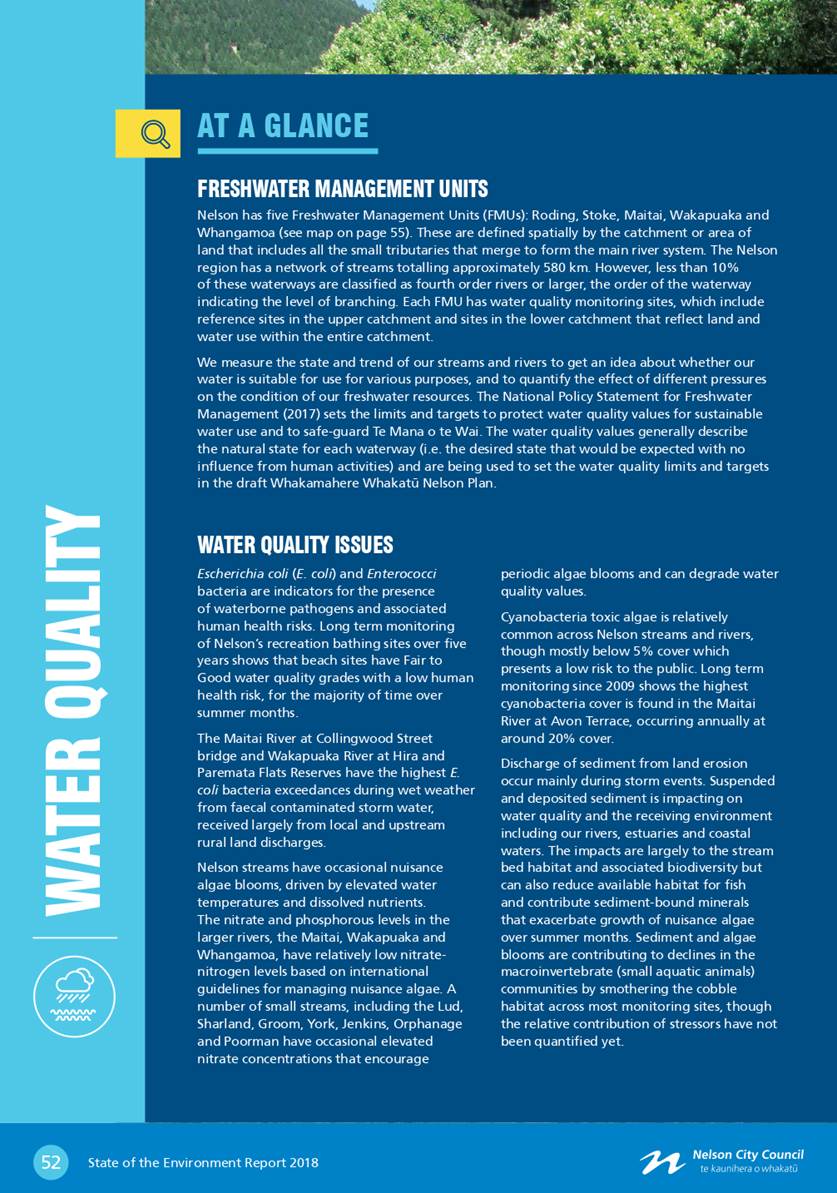















































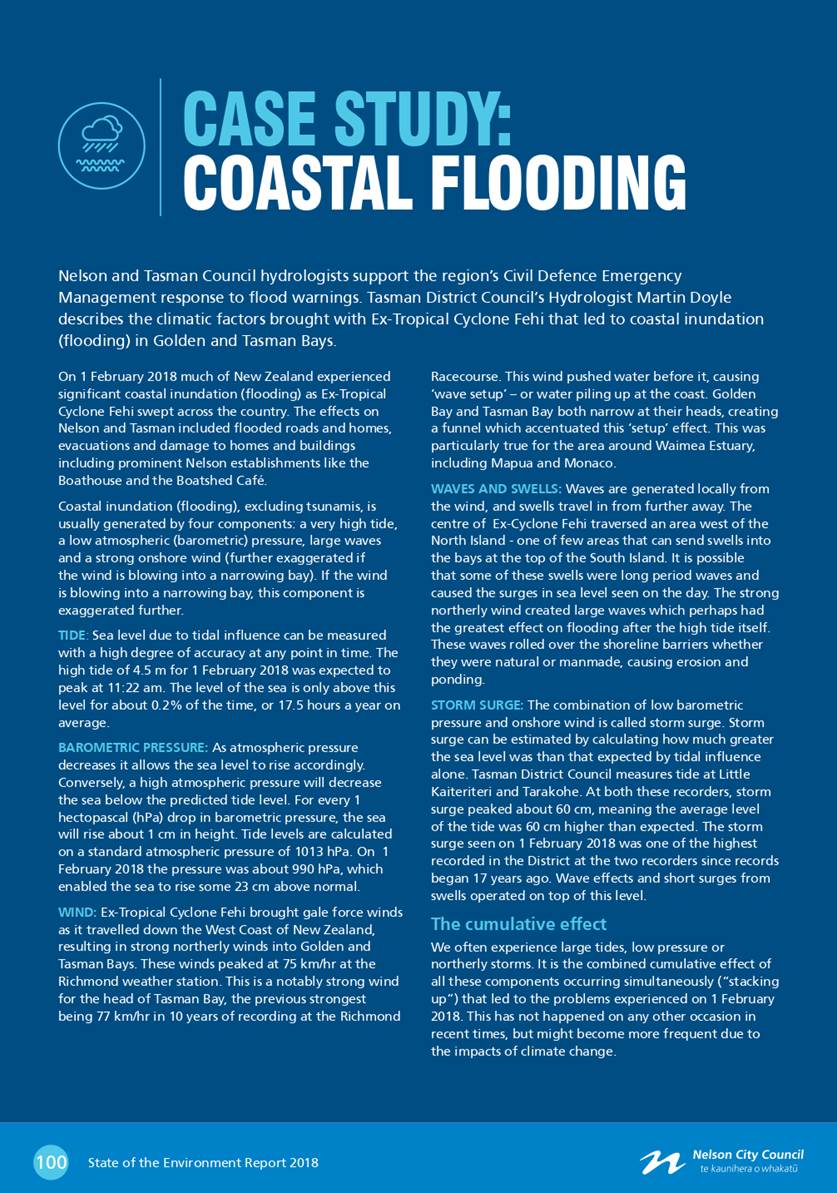











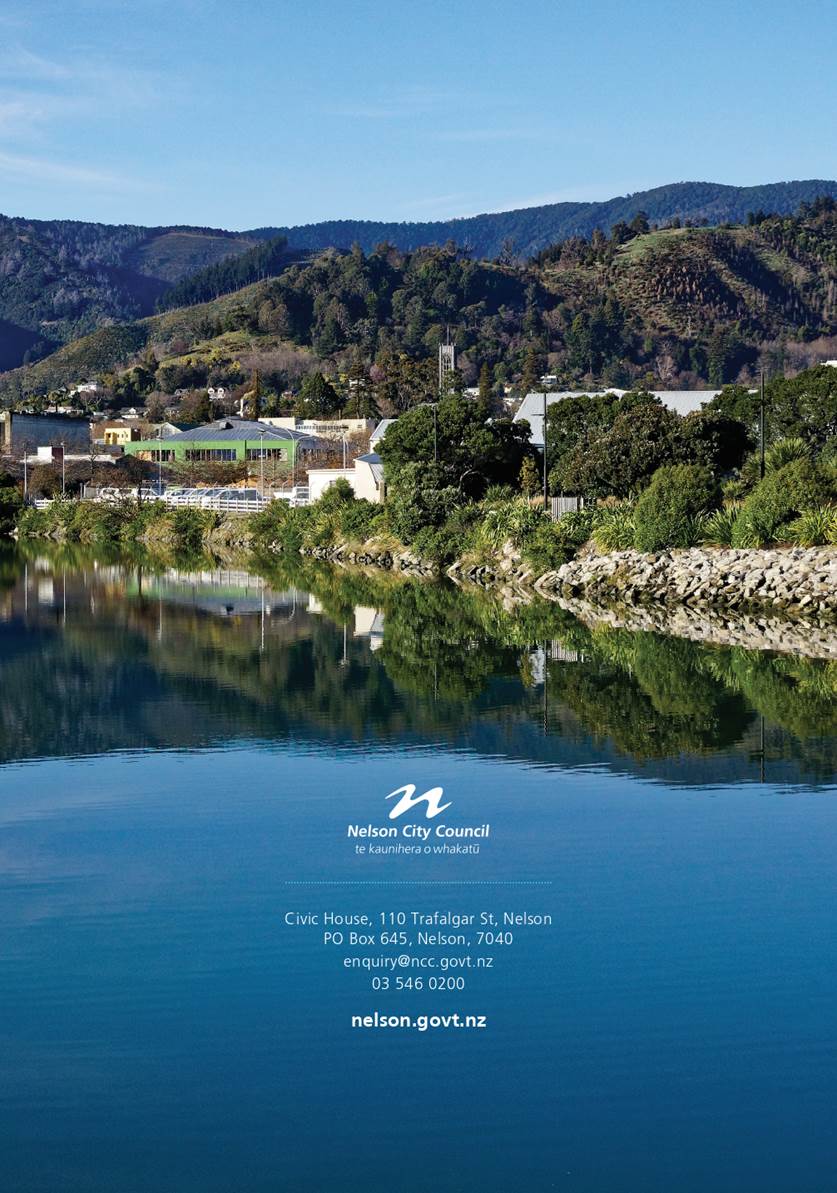
Item 8: Amendment to
Parking Policy - Parking Permits
|

|
Planning and Regulatory Committee
4 April 2019
|
REPORT R9946
Amendment
to Parking Policy - Parking Permits
1. Purpose of Report
1.1 To consider
amending the Parking Policy to enable the issuing of parking permits to jurors
that override time restrictions for parking while carrying out jury service at
the Nelson Courthouse.
2. Summary
2.1 Council has
received a request from the Nelson Courthouse to allow for the issuing of
parking permits to jurors while carrying out jury service at the Court.
The reasons for the request includes:
a) the
inconvenience of parking some distance away in non-time restricted areas while
carrying out their civic duty; and
b) safety
implications for the jurors if they have to walk some distance to their
vehicle, particularly in the evening.
2.2 The Parking
Policy would need to be amended to enable Council to issue parking permits for
jurors.
3. Recommendation
|
That the Planning and Regulatory Committee
1. Receives the report Amendment to
Parking Policy - Parking Permits (R9946)
and its attachment (A2147652).
|
Recommendation to Council
|
That the Council
1.
Approves Part 3.3 of the Parking Policy be amended to
include Jurors attending trials at the Nelson Courthouse as detailed in
Attachment 1 (A2147652) to Report R9946; and
2.
Approves amendments to the Parking Policy that update
references to Council officer positions where required as included in
Attachment 1 (A2147652) to Report R9946; and
3.
Delegates the Chief Executive the authority to amend the
criteria in Part 3.3 of the Parking Policy when required to minimise any
negative impacts of the parking permits on the users of the parking resource.
|
4. Background
4.1 The Nelson City
Council Parking Policy (the Policy) came into effect in December 2012 and since
then has been used to ensure that Council has a consistent and transparent
basis for the management of:
· Resident
Parking
· Carpool
Parking
· Reserved
Parking
· Mobility
Parking
· Senior
Parking.
4.2 Part 3.3 of the
Policy provides for reserved parking to those users who are not covered by
other parking schemes in the Policy. Users have to demonstrate private benefits
outweigh the cost to the public of having these parking spaces reserved.
4.3 The
issuing of permits for reserved parking is currently limited to:
· Councillors, the Mayor
and Executive Managers
· Environmental
Inspections Limited
· Visitors on Official
Business
· Tradespeople in the Central
Business District
· Mobility card holders
who work in the City.
5. Discussion
Parking Policy
5.1 In general,
public parking is for the use of the public. Parking restrictions such as
time limits and metered spaces (paid parking) are used to ensure everyone has a
fair opportunity to use the limited parking resource.
5.2 Any variations
from the above principle can benefit a specific user at a cost to the general
public. For example if permits are issued enabling a user to park without
having to comply with the restrictions, these spaces are unlikely to have the
same turnover and as a result the public are less likely to be able to find a
park in the area. This can potentially have negative impacts on
businesses in the area that rely on the turnover of parking spaces.
5.3 There are
exceptions to this as outlined in part 3.3 of the Parking Policy for reserved
parking where specific users have demonstrated a need which has private
benefits to a specific type of user which outweighs the cost to the
public. Council has been asked to extend the exceptions to include jurors.
Parking
permits for jurors
5.4 The Nelson
Courthouse has requested Council issue it with 12 permits for use by jurors
when attending jury service at the Nelson Courthouse. This would exempt
the permit holders from complying with the normal parking restrictions while
attending jury service.
5.5 The Court has
suggested that it could manage the issuing and retrieval of the permits from
jurors so there would be minimal Council staff input required.
5.6 Undertaking jury
service is a compulsory service for members of the community. It is often
considered a significant inconvenience as people take time away from their
normal lives to undertake this civic duty.
5.7 Currently there
is no special provision for jurors parking within the city and the Ministry of
Justice does not provide on-site parking for jurors. This means that if
jurors choose to park in town they legally must comply with the normal parking
restrictions, or park further away in unrestricted parking.
5.8 It has been
raised as a potential security concern by the Court that jurors coming to or
leaving the Court and walking some distance could be approached by associates
of the accused or others. The time when jurors are required at Court varies and
can extend into the evening.
5.9 Parking directly
outside the Nelson Courthouse on Bridge Street is time restricted parking as
follows:
· On the southern
side of Bridge St between Collingwood St and the Queens Park gates there are 33
parks where the maximum length of stay is one hour and there are three
accessible parks;
· On the southern
side of Bridge St between the Queens Park gates and the bridge there are four
spaces allowing up to two hours parking; and
· There are 32 parks
on the northern side of Bridge St between Collingwood St and the bridge
allowing parking up to one hour.
The
northern end of Tasman Street is free although it has a high occupancy rate as
it is some of the closest free parking to the City.
5.10 Car parking off street
surrounding the Courthouse is restricted to government centre staff and
visitors. There are 44 parks in the car park between the Courthouse and the
Suter and these are normally fully occupied by 8am. Between the Courthouse and
the Munro Building (Department of Conservation) there are three spaces that are
not time restricted or reserved for the Police, Department of Conservation or
Worksafe New Zealand vehicles.
5.11 Harley St (between Bridge
and St John Streets) has car pool parking, one space for up to 10 minutes and
eight spaces for up to two hours metered parking.

5.12 It is likely that if juror
permits were issued and the parking spaces on Bridge Street are occupied all
day near the Courthouse this will have a negative impact on the ability for
other members of the public to find parks in the area when visiting the Suter
or the gardens for example. The Suter has commented that if 12 parking spaces
were occupied all day in the vicinity of the Suter this would have a
significant impact on its customers.
5.13 The Suter states that it
already receives comments from people finding it hard to get a park as the theatre
can accommodate up to 150 people and the café can seat up to 80. It has
school groups visiting and occasionally buses with passengers from the cruise
ships.
5.14 Most other businesses in
this section of Bridge Street have off street parking for their staff and
clients.
5.15 Parking Officers report
that the streets around the Courthouse are usually full by 8am or soon after.
They suggest that Buxton Square is the closest option to the Courthouse that
could accommodate 12 parking permit vehicles for most times of the year. In
summer the parking square is often full by 10am so parks would not be able to
be guaranteed then. Parking Officers also recommend that the parking permits
exempt jurors’ vehicles from the time restriction and fees only. Vehicles
will still need to be warranted and registered and not parking in a loading
zone or accessible parking space.
Review
of restrictions or criteria
5.16 Part 3.3 of the Parking
Policy includes criteria for the issuing of parking permits. It is recommended
that should parking permits for jurors be issued, there will need to be
restrictions or criteria to mitigate impacts on their use as identified in
paragraph 5.15 above. It is recommended that the Chief Executive be given
authorisation to amend the criteria as needed. Any amendments will be to ensure
the impacts of the parking permits on the limited parking resource remains low.
Criteria in Part 3.3 are detailed in Attachment 1.
Other
amendments
5.17 References to Council
officer positions are out of date in the Parking Policy and these are proposed
to be amended at the same time as the changes identified above. Tracked changes
in Attachment 1 outline these position updates.
6. Options
6.1 The
preferred option is option 2.
|
|
|
Advantages
|
· A fair
for all approach to public parking
· Higher
turnover of spaces within the City
|
|
Risks and Disadvantages
|
· Potentially
increased security risk to jurors when leaving Court
· Inconvenience
and costs to jurors
|
|
|
|
Advantages
|
· Less
safety risk to jurors when leaving Court as security can accompany the group
to one location
· Less
inconvenience and cost to jurors
|
|
Risks and Disadvantages
|
· Lower
turnover of parking spaces in Buxton Square meaning more difficulty for the
public to find unoccupied parks in that area.
|
7. Conclusion
7.1 The time
restricted parking near the Courthouse causes a safety issue for jurors as they
have to park some distance from the Courthouse.
7.2 It is considered
reasonable that the Parking Policy be amended to enable the issuing of parking
permits (subject to criteria), for people carrying out jury duty so they are
not restrained by time limits or costs.
Author: Mandy
Bishop, Manager Consents and Compliance
Attachments
Attachment 1: A2147652
Proposed Parking Policy part 3.3 ⇩
|
Important considerations for decision making
|
|
1. Fit with Purpose of
Local Government
The recommendation in the report enables jurors to
park closer to the Courthouse without receiving parking enforcement penalties
while only having minor impacts on the performance of the parking regulatory
function overall.
|
|
2. Consistency with
Community Outcomes and Council Policy
The recommendation will contribute to achieving
community outcomes of having people friendly urban environments, supports
communities to be healthy, safe and resilient and fosters partnerships.
|
|
3. Risk
There is a minor risk the uptake of parking permits
by jurors can lead to reduced availability of the parking resource but the
restrictions can be reviewed and adjusted to minimise the impact.
|
|
4. Financial impact
The use of parking permits reduces the income from
metered time restricted spaces but this is not expected to impact on the
parking income by more than a minor amount. The administration of the permits
will have minimal staff time cost component.
|
|
5. Degree of significance
and level of engagement
This matter is of low significance because with the
restrictions imposed the negative impacts are not likely to be more than
minor and there will be positive response from jurors. Council officers have
liaised with the Suter staff as other businesses in the area provide their
own parking or attract fewer visitors.
|
|
6. Inclusion of
Māori in the decision making process
No engagement with Māori has been undertaken in
preparing this report.
|
|
7. Delegations
The Planning and Regulatory Committee has the following
delegations to consider
Areas of Responsibility:
· Parking
Policy and Regulation
Powers to Decide:
· Not
applicable
Powers to Recommend:
· Development
or review of policies and strategies relating to the areas of responsibility
|
Item 8: Amendment to Parking Policy - Parking Permits: Attachment 1
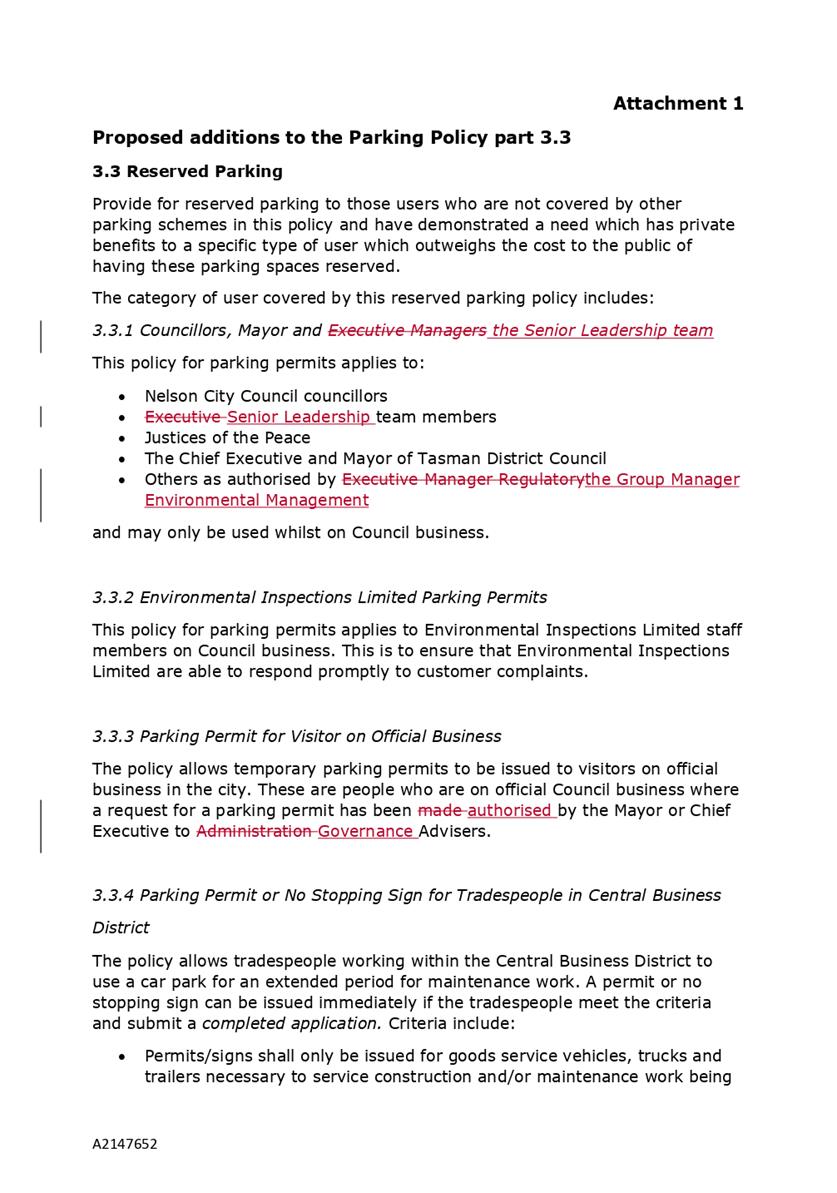

Item 9: Navigation
Safety Bylaw review
|

|
Planning and Regulatory Committee
4 April 2019
|
REPORT R10026
Navigation
Safety Bylaw review
1. Purpose of Report
1.1 Following a
review of the Navigation Safety Bylaw 2012 (No. 218), (the Bylaw), the report recommends
that it be amended and a Special Consultative Procedure (SCP) commences for the
proposed amendments.
2. Summary
2.1 A review of the
Bylaw has identified that provisions need updating to be:
a) more
consistent with national statutes specifically the Maritime Transport Act and
Rule provisions; and
b) better
reflect current best practice to ensure the safety of people using the sea and
rivers for a variety of water activities; and
c) reduce
conflicts between different activities.
2.2 Key recommended
changes include a requirement to wear lifejackets in vessels six metres or less
in length and for recreational vessels to be registered.
3. Recommendation
|
That the Planning and Regulatory Committee
1. Receives the report Navigation
Safety Bylaw review (R10026)
and its attachment (A2144429).
|
Recommendation to Council
|
That the Council
1. Notes
the review of the Navigation Safety Bylaw 2012 (No. 218); and
2. Determines
amendments to the Navigation Safety Bylaw 2012 (No. 218) are the most
appropriate way of addressing the navigation safety problems identified by
the review; and
3. Determines
the proposed amendments to the Navigation Safety Bylaw 2012 (No. 218) are the
most appropriate form of bylaw and do not give rise to any implications under
the New Zealand Bill of Rights Act 1990; and
4. Determines
a summary of the Statement of Proposal Proposed Changes to the Navigation
Safety Bylaw 2012 (No. 218) is not required; and
5. Adopts
the Statement of Proposal Proposed Changes to the Navigation Safety Bylaw
2012 (No.218) (A2144429 of Report R10026); and
6. Approves
the commencement of the Special Consultative Procedure (A2144429 of Report
R10026), with the consultation period to run from 21 June to 24 July 2019;
and
7. Approves
the consultation approach (set out in paragraphs 5.9 and 5.10 of Report
R10026) and agrees:
(a) the plan includes sufficient steps to ensure the
Statement of Proposal will be reasonably accessible to the public and will be
publicised in a manner appropriate to its purpose and significance; and
(b) the plan will result in the Statement of Proposal
being as widely publicised as is reasonably practicable as a basis for
consultation.
|
4. Background
4.1 The Local
Government Act 2002 (LGA) requires that bylaws are reviewed five years from the
date on which the bylaw was made. The Navigation Safety Bylaw was due for
review by 1 December 2017, but can remain in force provided that a review is
completed by 1 December 2019. On 25 May 2017 the Planning and Regulatory
Committee approved completion of the review by 1 December 2019.
4.2 Council must
complete a review by making the determinations required by section 155 LGA. Section
155 of the LGA requires Council to determine whether amendment, revocation or
replacement of the bylaw is the most appropriate way to address any perceived
problems arising from the review and, if so, whether the proposed changes are
the most appropriate form of the bylaw and gives rise to any implications under
the New Zealand Bill of Rights Act 1990 (NZBORA).
4.3 Section 156 of
the LGA requires Council to use the SCP before making a decision to amend a
bylaw if the local authority considers there is, or is likely to be, a
significant impact on the public from the proposed bylaw changes.
4.4 When carrying
out an SCP (as outlined in section 83 of the LGA) the Council must:
· prepare and adopt a
statement of proposal
· consider whether a
summary of the Statement of Proposal is necessary to enable public
understanding of the proposal.
· make the statement of
proposal publicly available for at least one month and invite written
submissions
· provide an opportunity
for people to present their views to the local authority in person
4.5 Under section 86
of the LGA, the statement of the proposal must include:
· A draft of the
bylaw as proposed to be amended; and
· The reasons for
the proposal; and
· A report on any
relevant determinations by Council under section 155 LGA.
4.6 Since
Council’s Navigation Safety Bylaw came into effect on 1 December 2012 the
most relevant Maritime rules, (Part 91 Navigation Safety Rules made under the
Maritime Transport Act 1994), have been amended three times. Maritime New
Zealand safety campaigns have more recently joined forces with Harbourmaster
activities to educate and enforce consistent safety messaging.
5. Discussion
Nelson has one of the highest
tidal ranges in the country and a narrow cut through the Boulder Bank. A high
level of navigation safety measures are required to mitigate risks to vessels
and people’s health and safety in these conditions.
Review
of the Bylaw
5.1 Prior to the
writing of this report recreational water sport clubs and organisations were
contacted asking for their views on whether the Bylaw needs changing. No
comments were received.
5.2 Council officers
have undertaken a review of the Bylaw with the Harbourmaster and Deputy
Harbourmaster. The review has identified some bylaw clauses are inconsistent
with national safety campaigns and some terms are inconsistent with national
regulation. Officers consider that amendment of the Bylaw is the most
appropriate way to address these problems.
5.3 The Bylaw
incorporates marina management activities that are not found in other Council
Navigation Safety Bylaws particularly when their marina is operated by a
separate commercial company or a Council Controlled Organisation. However a
full review of the Bylaw to address these clauses would be premature before a
review of the Nelson marina operation and licensing is carried out. Proposed
changes to the Bylaw as an outcome of this review are therefore limited to
making clauses more consistent with national statutes and addressing potential
safety problems identified by the Harbourmaster.
5.4 The specific
amendments proposed to address the problems identified in the review are
addressed in more detail below. Officers consider that these proposed changes
are the most appropriate form of bylaw.
5.5 Council officers
have considered whether the proposed changes give rise to any implications
under the NZBORA. A bylaw is considered an appropriate way of managing a range
of water based activities to minimise harm to people and property. The
Navigation Safety Bylaw seeks to protect life (that is consistent with section
8 of the NZBORA) and enable the safe movement of vessels. The Bylaw controls
the speed and priority of movements in areas where potential conflict and harm
can occur (such as transiting through the Cut). While this could be considered
a restriction of freedom of movement under section 18 of the NZBORA, the
limitations are designed to restrict people’s movement and behaviour as
little as is reasonably required to protect life and property. The proposed
limitations are therefore considered reasonable and justified under the NZBORA.
Proposed
changes
5.6 All proposed
changes are detailed in Attachment 1. The provisions have been the subject of a
legal review. There are some updates to words or references to be more
consistent with national provisions and remove duplication. The main changes
are:
|
Clause
|
Add, amend or delete
|
Reason
|
|
2.7 d)
|
Amend from the person in charge of
a vessel less than six metres in length to ensure each person shall wear a
lifejacket unless the person in charge permits people to not wear them to
require all persons to wear lifejackets in vessels six metres or less in
length (with some exemptions).
|
Safety - checks conducted by the Harbourmaster
revealed only about a third of skippers have completed a day skipper or boat
masters course. The current Bylaw provisions mean passengers rely on the
judgement of skippers to decide when to wear a lifejacket. Approximately 82 %
of all drowning deaths involve males who underestimate the risks of not
wearing a lifejacket and overestimate their level of competence (NZ Safer
Boating Forum). The wearing of lifejackets all of the time has been the key
message in recent Maritime New Zealand safer boating campaigns. At least
eight regional or district councils already have a bylaw requiring the wearing
of a lifejacket at all times on recreational vessels six metres or less in
length. Most drownings in boating accidents involve craft under six metres
and most accidents occur suddenly with no warning (Maritime NZ website). Not
wearing a lifejacket is the leading risk factor for boating fatalities. Two
thirds of those who die in recreational boating accidents each year could
have been saved had they been wearing a lifejacket (NZ Safer Boating Forum).
Safety checks conducted by Nelson’s Deputy Harbourmaster has found
nearly all vessels carry lifejackets but in some weeks the percentage of
people wearing the lifejackets has been as low as 68%.
Current exemptions to wearing lifejackets
remain. These include:
· kite surfers wearing wetsuits;
· surfers with a leg or waist rope; and
· events or activities where there is a support vessel
carrying personal floatation devices in the immediate vicinity.
|
|
2.11
|
Amend the lookout requirement when a
vessel is towing a person to be at any speed, not just when the speed exceeds
five knots
|
Safety – surveillance of the person
being towed needs to occur at all times at all speeds by someone other than
the person operating the vessel
|
|
2.16 c)
|
Add a requirement that any person placing
a marker buoy (with the permission of the Harbourmaster) clearly labels the
buoy and ensures it is visible
|
Safety - to avoid the buoy being a hazard
to navigation
|
|
2.26 c)
|
Add a requirement to register vessels
where the identifying name or number is not the vessel’s trailer registration
number
|
Safety – Registration of the vessel
with the name and contact details of the owner will improve rescue
operations. It will also enable the enforcement of the Bylaw should the
Harbourmaster be unable to approach the vessel at the time of non-compliance
|
|
2.27
|
Add a requirement to nominate a person as
the person in charge of the vessel
|
Safety – this clause reinforces the
responsibilities of the person in charge of the vessel under the Bylaw and
Maritime Rules to ensure the safety on every person on board and for the safe
operation of the vessel. Nationwide
evidence has shown boats involved in accidents have been under equipped with
skippers lacking basic knowledge of key boating safety rules.
|
|
2.28
|
Add a requirement to carry two forms of communication,
at least one must be able to operate in the water
|
Safety – this clause is consistent
with nationwide safety messages. The communication needs to be appropriate
for the area the vessel will be operating in
|
|
2.29
|
Add a requirement to ensure the vessel is
not overloaded or operated in a manner causing instability
|
Safety – to minimise the risk of
the vessel overturning or being swamped
|
|
3.3
|
Delete the clause relating to consumption
of alcohol
|
Consistency – The Ministry of
Transport reviewed the Bylaw provisions when gazetting the infringement
regime and determined this clause was able to be enforced under the Bylaw
|
|
3.14
|
Amend the clause to enable the
Harbourmaster to close areas of the harbour to fishing after giving notice
|
Safety – to minimise potential risk
when there are organised activities in a particular area
|
|
3.22
|
Amend the clause to replace the word
“cleaning” with “inspecting”
|
Consistency – the Resource
Management Act does not permit a discharge of a contaminant to water. The
cleaning of a vessel or equipment should occur out of water or in a contained
manner or under conditions of a resource consent
|
|
6.9 e)
|
Add a clause to enable volunteers to
assist the Harbourmaster with land based safety checks
|
Safety – to provide more resource
in carrying out safety checks before the vessel goes out on the water.
The volunteers will be vetted by the
Harbourmaster for suitable technical knowledge and to ensure their
interaction with the public upholds Council’s customer service values
and behaviours
|
|
Map 3
|
Amend to reflect what can safely occur in
the area given the increased numbers of swing moorings. The water ski/ wake boarding/biscuiting area is
deleted.
|
Safety - The area identified is too small
for these activities and it would clash with the rowing and waka ama activities
that occur in the area
|
|
Map 6
|
Amend the skiing/jet skiing area
|
Consistency - to match the markers on
land
|
|
Map 7
|
Add a map to identify the cruise ship
anchoring area
|
Consistency – Port Nelson directs
cruise ships to anchor in this location. It may be used for other purposes
when not required for this activity
|
|
Appendix 1
|
Amend the infringement schedule wording
|
Consistency – terms are changed or
deleted to be the same as the Maritime Transport (Infringement Fees for
Offences – Nelson City Council Navigation Safety Bylaw 2012)
Regulations 2015
|
|
Appendices 2 - 6
|
Delete the forms
|
Consistency – these forms are out
of date. Reference to forms in the Bylaw have been amended to refer to the
Council’s website
|
Public
consultation
5.7 A SCP is
required when the changes to a bylaw create a significant impact on the public
(section 156 of the LGA). The proposed changes to the wearing of lifejackets
and vessel registration could impact a number of people albeit these measures
are to enhance their safety. The changes to the priority areas could also
impact a number of people who currently use these areas.
5.8 A summary of
proposed changes to the Bylaw was forwarded to the clubs in mid-March inviting
their feedback prior to the formal consultation process. A verbal update on
their response will be provided at the Committee meeting.
5.9 The draft SOP is
included as Attachment 1. Following adoption of the SOP it will be made
available to the public for feedback, with a proposed consultation period from
21 June to 24 July 2019.
5.10 Holding a hearing on 6
August 2019 followed by deliberations on 22 August would enable a
recommendation to be considered by full Council on 19 September, with any Bylaw
changes to take effect from 1 October 2019.
6. Options
6.1 The main options
are to either:
· Determine that the
Bylaw should not be changed or (option 1);
· Adopt the
Navigation Safety Bylaw statement of proposal in Attachment 1 for the special
consultation procedure (option 2); or
· Direct officers to
amend the statement of proposal (option 3).
The
preferred option is option 2.
|
|
|
Advantages
|
· No
additional requirements for vessel owners
· No
staff time required to administer changes
|
|
Risks and Disadvantages
|
· The
Bylaw remains inconsistent with national regulations and safety campaigns
· The
Council will carry the risk of potentially not having done everything it
could to prevent water activity accidents
|
|
|
|
Advantages
|
· Consultation
can commence earlier
· Proposed
amendments are based on recommendations from officers administering and
enforcing the Bylaw
|
|
Risks and Disadvantages
|
· Some
vessel owners may oppose the proposed changes
· The
administration of the registering of the vessel may not be welcomed by vessel
owners and will take staff time to establish and maintain
|
|
|
|
Advantages
|
· Amendments
may reduce the potential level of opposition from vessel owners
|
|
Risks and Disadvantages
|
· Amendments
may not be consistent with national safety campaigns or regulations
· Delayed
consultation may result in not meeting Bylaw review timeframes
|
7. Conclusion
7.1 Since the Bylaw
came into effect in December 2012 Maritime Rules have been updated, local
safety checks have been conducted and national safety campaigns have occurred.
Proposed changes to the Bylaw seek to better align Bylaw provisions with these
aspects to enhance the safety of people involved in water activities.
Author: Mandy
Bishop, Manager Consents and Compliance
Attachments
Attachment 1: A2144429
Navigation Safety Bylaw - Statement of Proposal ⇩
|
Important considerations for decision making
|
|
1. Fit with Purpose of
Local Government
Navigation safety is the responsibility of regional
councils and the recommendations in this report support the performance of
the Harbourmaster duties to ensure public safety.
|
|
2. Consistency with
Community Outcomes and Council Policy
Enhancing navigation safety ensures the Community
Outcome of having access to a range of social, education and recreational
facilities and activities namely high quality water sport activities. It also
ensures the safe operation of Port activities that support our region having
an innovative and sustainable economy.
|
|
3. Risk
Council is responsible for ensuring navigation
safety on our navigable waters. There is a moderate risk in not updating and
amending the Navigation Bylaw in accordance with current national provisions
and safety advice. The recommendations seek to enhance safety and reduce risk
to people involved in water activities. Reducing the potential for accidents
also reduces the risk to the environment from pollution. The risk in amending
the Navigation Bylaw as proposed is that some people may resent the changes,
even though they are designed for their own safety.
|
|
4. Financial impact
The recommendations will require staff time to
administer the proposed changes but this is expected to be accommodated
within existing resources.
|
|
5. Degree of significance
and level of engagement
This matter is of medium significance because proposed
changes will impact on a number of recreational sea and river activities.
Therefore consultation will occur in the form of a special consultative
procedure.
|
|
6. Inclusion of
Māori in the decision making process
No engagement with Māori has been undertaken in
preparing this report.
|
|
7. Delegations
The Planning and Regulatory Committee has the following
delegations to consider
Areas of Responsibility:
· Considering
maritime and harbour safety control matters
· Bylaws
Powers to:
· Hear and
deliberate on submissions to proposed changes to the Bylaw
Powers to Recommend:
· The
statement of proposal for Bylaw consultation
· Final
decisions on any Bylaw changes
|
Item 9: Navigation Safety Bylaw review: Attachment 1
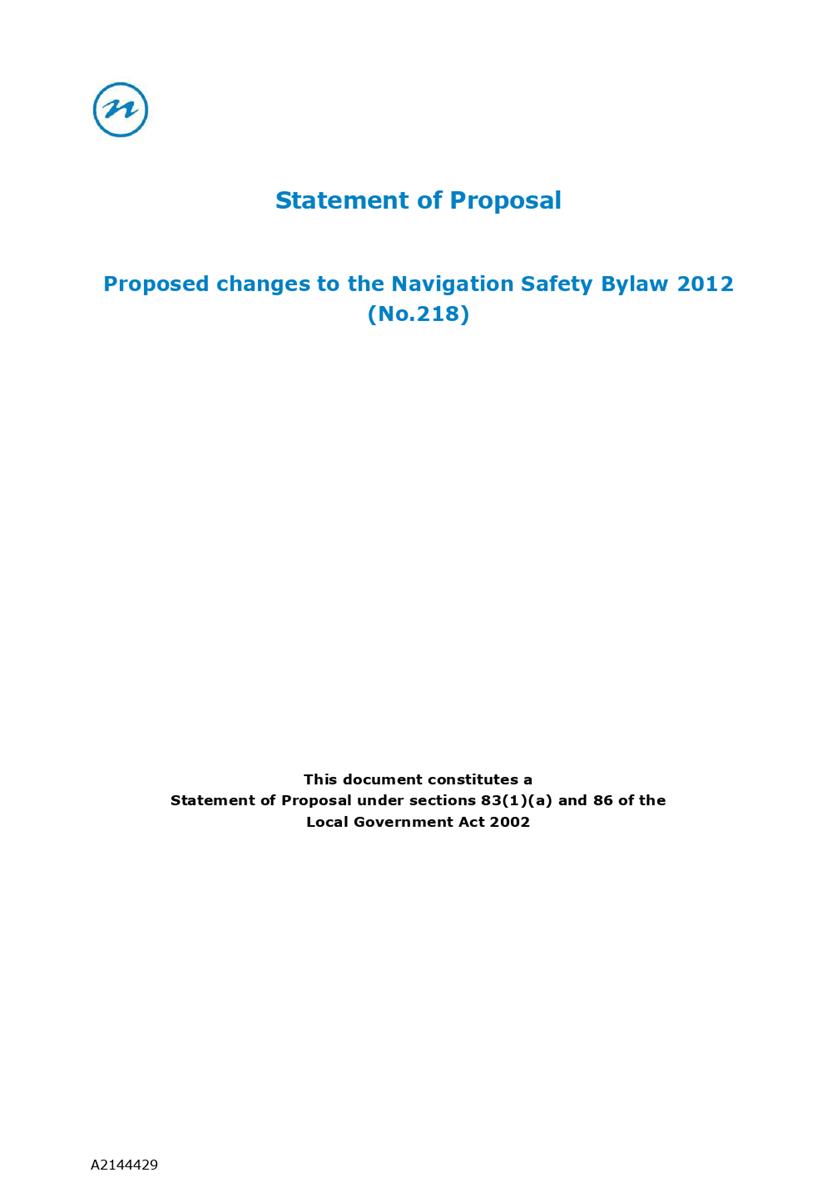








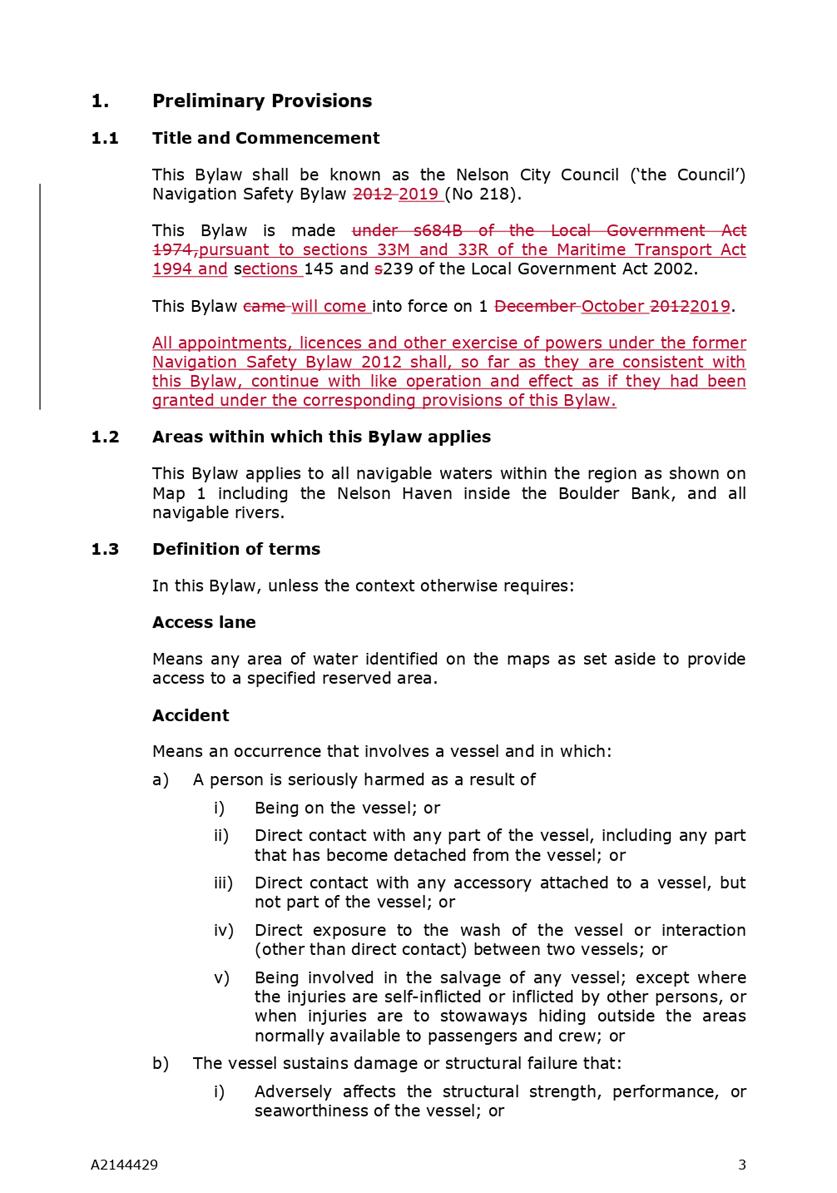



















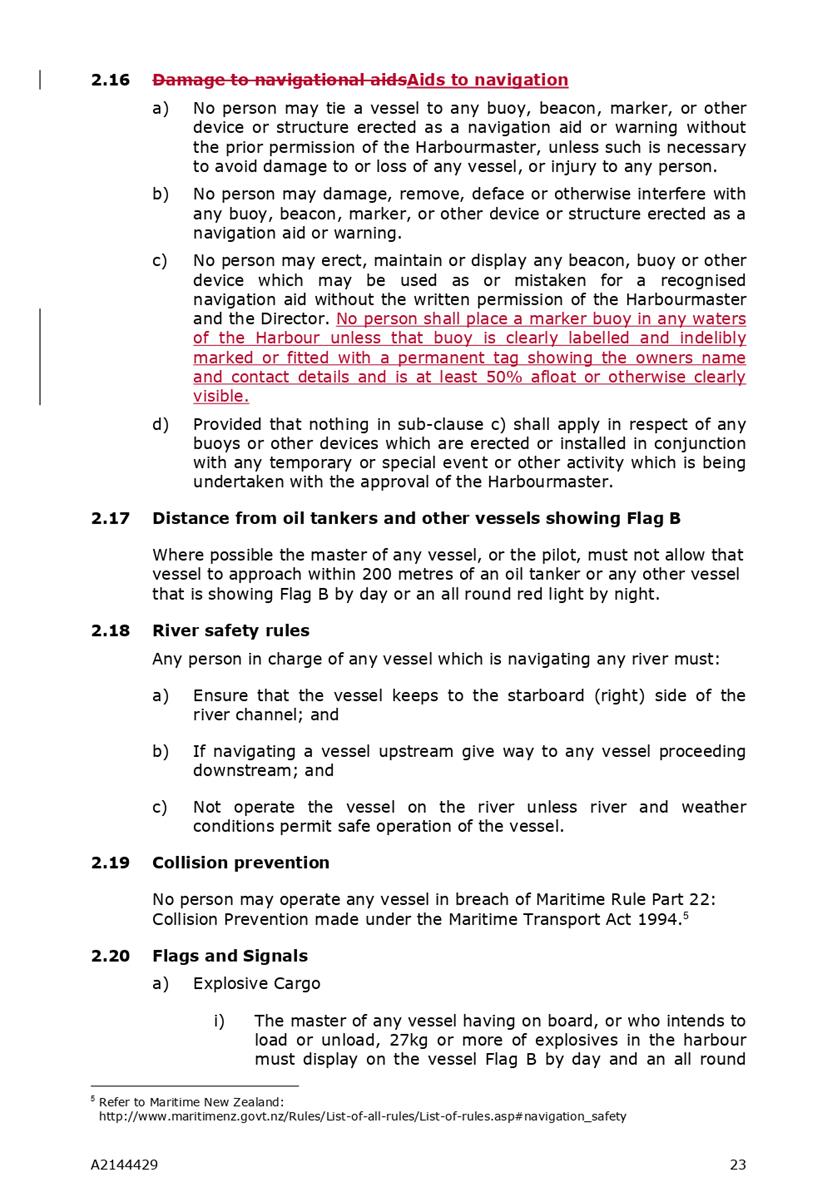








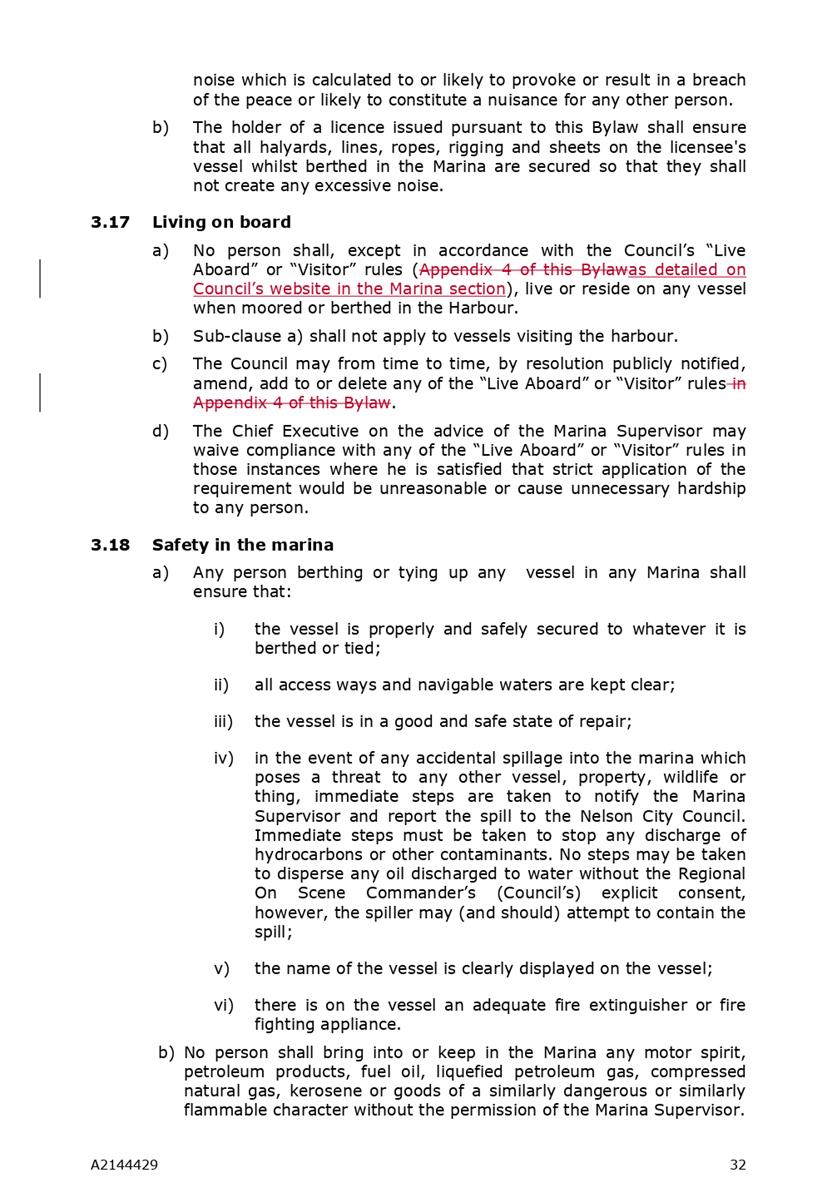





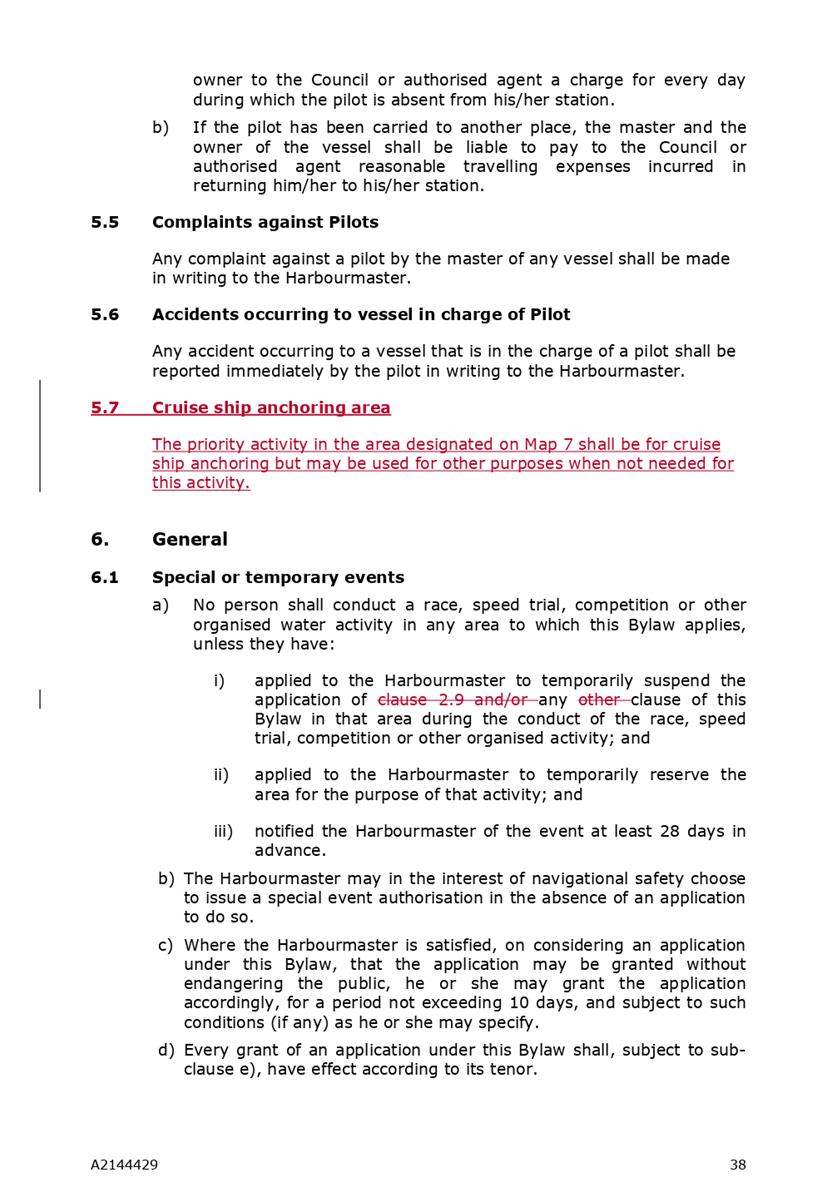

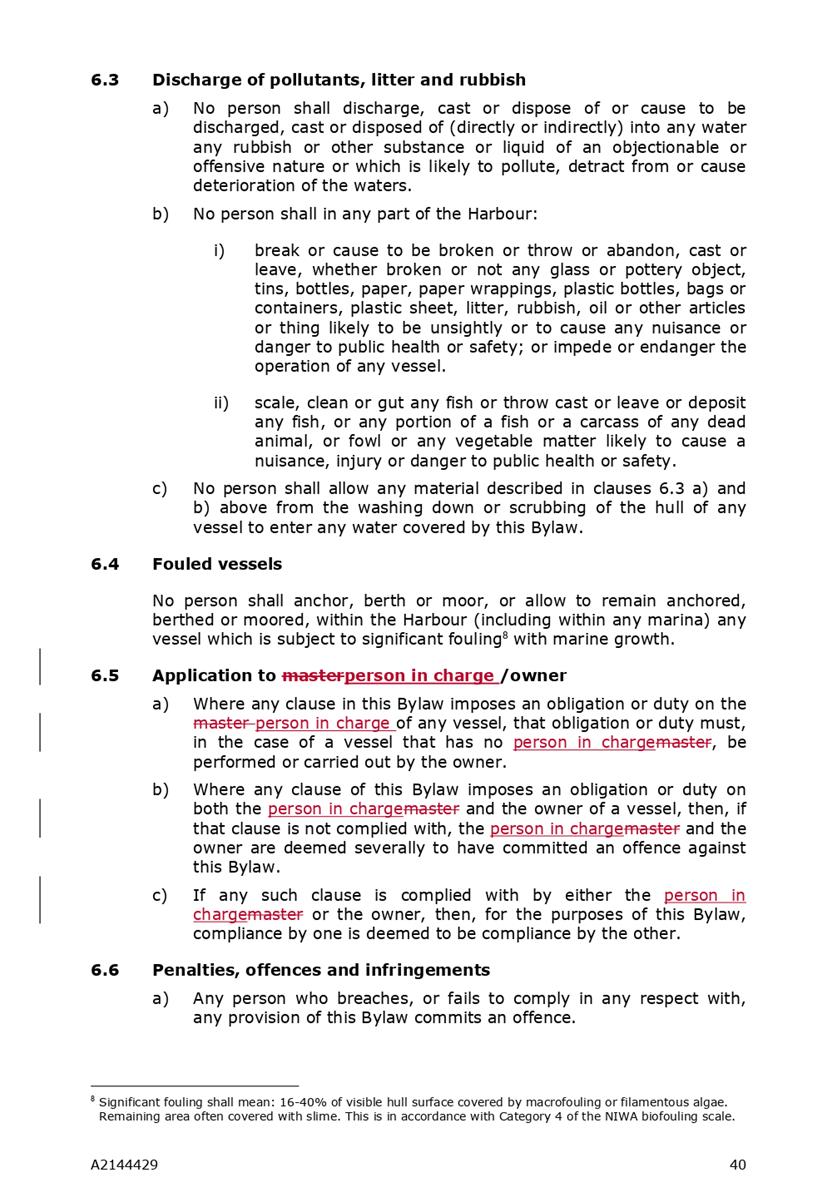


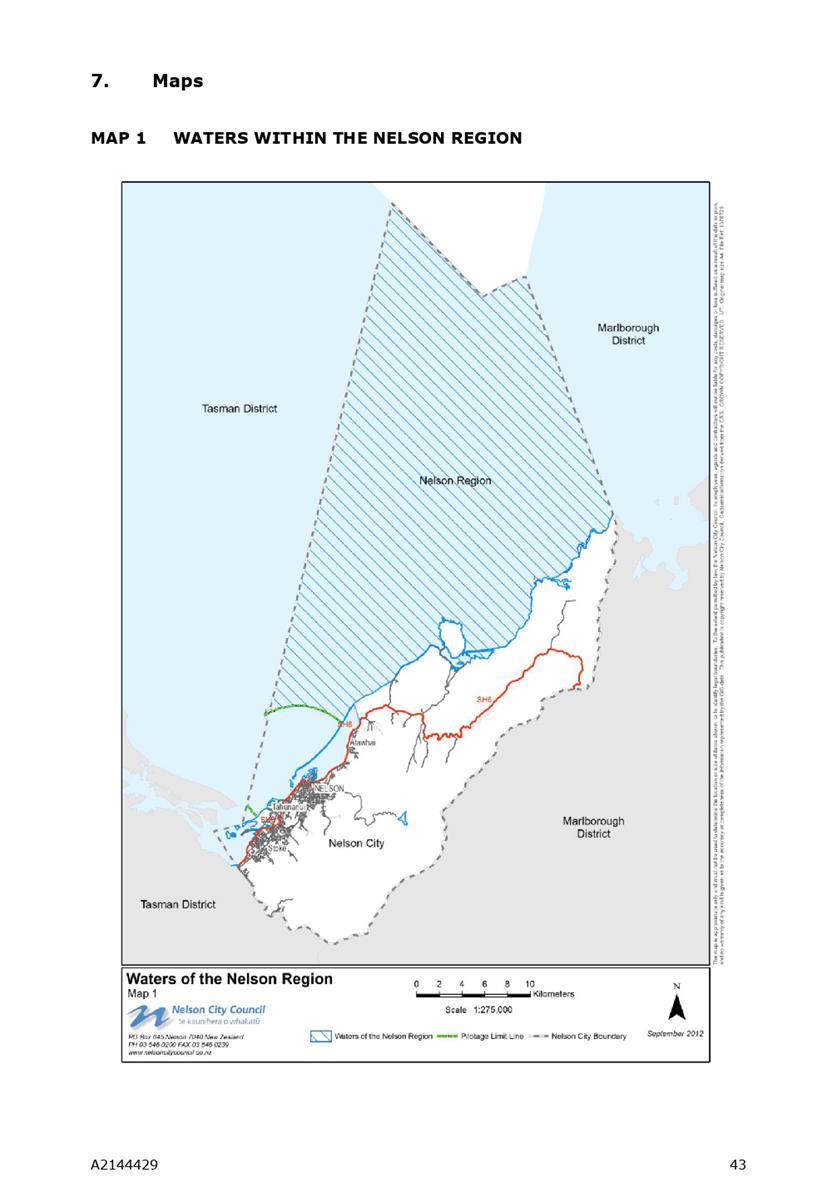




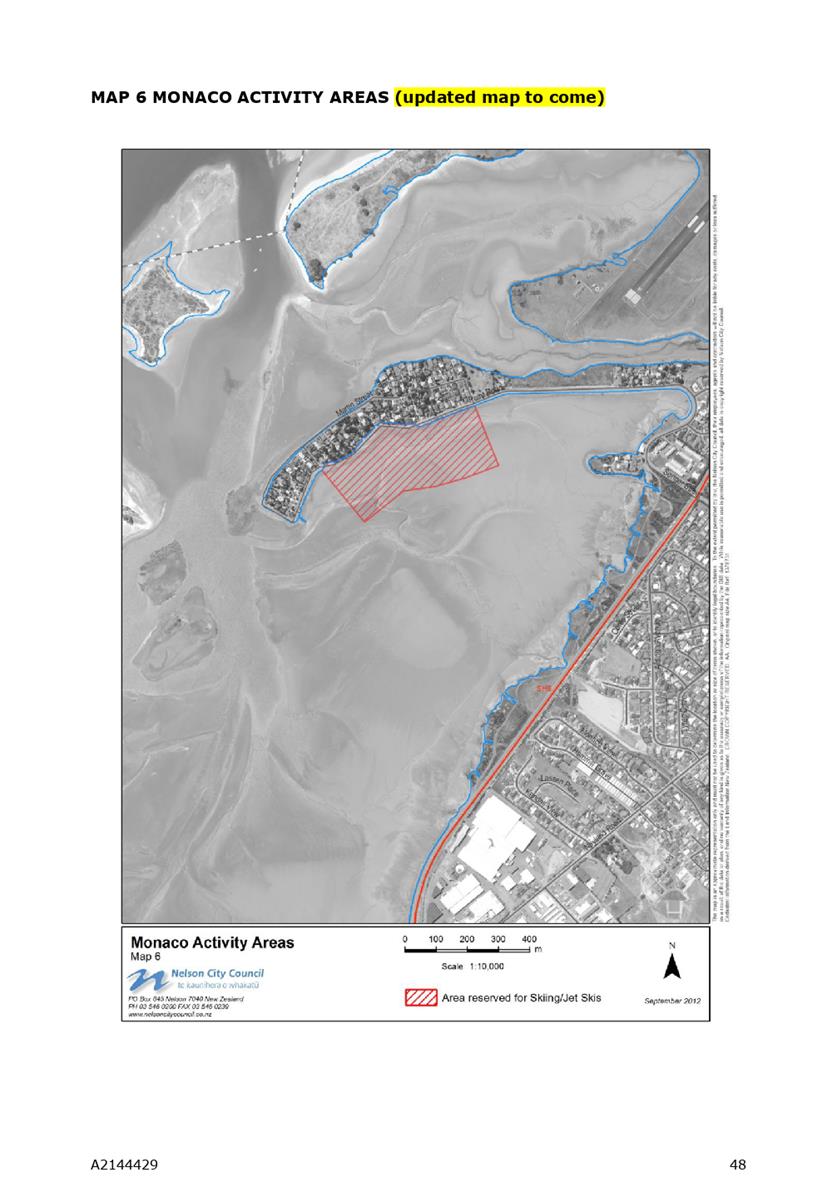










Item 10: Proposed Dog
Control fees and charges
|

|
Planning and Regulatory Committee
4 April 2019
|
REPORT R10031
Proposed
Dog Control fees and charges
1. Purpose of Report
1.1 To approve the
fees and charges for the dog control activity to take effect from 1 July 2019.
2. Summary
2.1 The dog control
fees and charges have not changed since 1 July 2015. Proposed increases to
registration and impounding fees better enables the dog control income to fully
meet the costs of the dog control activity.
3. Recommendation
|
That the Planning and Regulatory Committee
1. Receives the report Proposed Dog
Control fees and charges (R10031)
and its attachment (A2145361).
|
Recommendation to Council
|
That the Council
1.
Approves the Dog Control fees and charges as detailed in
Attachment 1 (A2145361) to report R10031 to take effect from 1 July 2019.
|
4. Background
4.1 Section 37 of
the Dog Control Act 1996 gives local authorities the power to set charges for
dog registration and other dog control activities. Section 37(4) requires the
territorial authority to have regard to the relative costs of the registration
and control of dogs in the various categories. Section 37(8) states any
increase in fees can only take effect at the commencement of that year.
4.2 The dog control
fees and charges were last changed in 2015. For the 2015/16 financial year the
fees met 98% of the costs and all costs were met by fees for 2016/17. In
2017/18 the fees met 85% of the costs or 91% of the costs when the extension to
the pound is excluded.
4.3 The shortfall in
the last financial year was covered by the dog control reserve account. This
account is nearing depletion. The dog control activity should be cost neutral
to ratepayers.
5. Discussion
5.1 The dog control
activity is funded mostly by registration fees, dog impounding fees and some
minor income from infringement fees and Court awarded costs.
5.2 The costs of the
dog control activity are largely fixed being adjusted only by the Consumer
Price Index (CPI). The number of dog registrations generally increase on
an annual basis which can lead to an increase in the required service level.
5.3 There was an
increase in dog registrations of 2% from 2015/16 to 2016/17 and an increase of
1.7% from 2016/17 to 2017/18. However the forecasted income for 2018/19 is
expected to be less than the forecasted costs by 1.8%. The difference is due to
a decrease in the impounding income and an increase in doggie do bag costs.
Fees and charges will need to be increased to cover these factors so future
budgets will achieve a cost neutral outcome.
5.4 The proposed
increase in registration fees in attachment one is based on an increase of 1.8%
and rounded to the nearest ten cents. The increase in impounding fees is
greater than 1.8% for the first impoundment and the after-hours call out charge
to better reflect the costs for officer time for these tasks. The second and
third impoundment fees double and triple the first impounding fee to
incentivise repeat offenders to resolve the issue.
5.5 The same
percentage increase in the various categories of registration fees maintains
the lower fees for neutered dogs, rural dogs and those qualifying for good dog
ownership. The relative costs of registration in the various categories are
therefore unchanged by the proposal.
Options
5.6 The preferred
option is option 2 – increase the charges as proposed. Fees and charges
can be reviewed at any time to ensure costs of the service are being met. The
fees and charges will be reviewed after the decisions on any changes to the dog
control policy and bylaw have been made.
|
|
|
Advantages
|
· Dog
owners do not face increased fees
|
|
Risks and Disadvantages
|
· The
cost of the dog control activity is not fully met by income from fees and
charges requiring supplementation from ratepayers
· The
increase to fees and charges may need to be bigger at a later date
|
|
|
|
Advantages
|
· The
cost of the dog control activity will more likely be met by income from fees
and charges with no supplementation from ratepayers
|
|
Risks and Disadvantages
|
· Dissatisfaction
by dog owners for the increase in costs could increase the occurrence of
non-payment that requires more staff time to follow up
|
6. Conclusion
6.1 Registration
fees need to increase by 1.8% to cover increased costs in providing the dog
control service.
6.2 Proposed changes
to registration and dog control fees are in accordance with section 37 of the
Dog Control Act 1996.
Author: Mandy
Bishop, Manager Consents and Compliance
Attachments
Attachment 1: A2145361
Proposed dog control fees and charges ⇩
|
Important considerations for decision making
|
|
1. Fit with Purpose of
Local Government
The recommendation in the report provides for the cost-effect
delivery of the dog control regulatory function.
|
|
2. Consistency with
Community Outcomes and Council Policy
The recommended fees and charges are consistent with
statutes and assist with achieving the funding outcomes in the Long Term
Plan.
|
|
3. Risk
The do nothing option will likely not achieve the
funding outcomes stated in the Long Term Plan.
|
|
4. Financial impact
In the short-term the dog reserve account
(accumulated when fees and charges exceeded the costs of the service) may
cover any shortfall but medium to long-term costs of the service are unlikely
to be met through the fees and charges income if this is not increased.
|
|
5. Degree of significance
and level of engagement
This matter is of low significance because the
amount of increase is not significant for most dog owners. The fees and
charges have not increased since 2015 and this will be conveyed to dog owners
prior to reregistration.
|
|
6. Inclusion of
Māori in the decision making process
No engagement with Māori has been undertaken in
preparing this report.
|
|
7. Delegations
The Planning and Regulatory Committee has the following
delegations to consider dog control fees and charges
Areas of Responsibility:
· Animals
and Dogs
Powers to Decide:
· Not
applicable (there is no delegation from the Council to set fees and charges)
Powers to Recommend:
· The
setting of fees and charges
|
Item 10: Proposed Dog Control fees and charges: Attachment 1



 Planning and Regulatory
Committee
Planning and Regulatory
Committee




















































































































































































